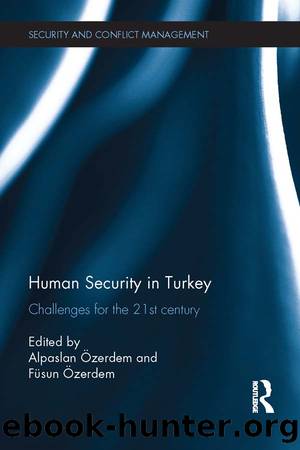Human Security in Turkey by Alpaslan Özerdem Füsun Özerdem

Author:Alpaslan Özerdem, Füsun Özerdem [Alpaslan Özerdem, Füsun Özerdem]
Language: eng
Format: epub
ISBN: 9781136658174
Barnesnoble:
Publisher: Taylor & Francis
Published: 2013-07-04T00:00:00+00:00
Social exclusion in Turkey and Ä°stanbul
Turkey, a bridge between Asia and Europe, has a population of more than 72 million and it is a rapidly developing country, introducing reforms in various domains. Although Turkey is not an EU member state, its long, exhausting but ambitious journey to full membership, which started in 1959 with the application for associate membership of the EEC, still continues. Turkey has prepared its Joint Inclusion Memorandum, which is a requirement set by the EU for candidate countries (General Directorate of Social Assistance and Solidarity, Turkey 2011). This memorandum is also a sign that Turkey has accepted the European approach and tools in its social inclusion efforts.
As is the case in many developing countries, inequality of income is one of the basic socio-economic problems in Turkey. It has the highest inequality of income distribution among European countries, with an S80/S20 income quintile share ratio of 10, twice the EU average (Eurostat 2008). The unemployment rate was around 11 per cent as of November 2010 (Office for National Statistics, Turkey 2011), while that of the EU-27 was 9.6 per cent (Eurostat, http://epp.eurostat.ec.europa.eu). In Turkey, the risk-of-poverty was around 25 per cent in August 2010, compared to 15.4 per cent in the EU-27 (Eurostat, http://epp.eurostat.ec.europa.eu). In brief, all these statistics give a rough picture of social exclusion in Turkey, as poverty, unemployment and inequality of income distribution are the main features of social exclusion. This picture also gives an idea of the situation in Ä°stanbul, where nearly one-fifth of the total population in Turkey lives.
The educational situation is also important to understand the present context. As of 2006, 12 per cent of the Turkish population is illiterate and average years of schooling completed is around six. As of 2008, only 58 per cent of adults who had completed compulsory eight-year education entered secondary education and 21 per cent of them continued to universities (Turkish Statistical Institute 2011a). In Ä°stanbul, as of 2011, among the population aged six and over, 3 per cent are illiterate, 15 per cent are literate but did not finish any school, primary-school graduates are 40 per cent, high-school graduates are 15 per cent and the proportion of university graduates is around 12 per cent (Turkish Statistical Institute 2011b). These figures indicate the low educational level in Ä°stanbul, which is regarded as one of the main reasons for poverty and social exclusion.
In order to understand the problem of social exclusion and the socio-cultural structure in Ä°stanbul, one must know about the mass immigrations to the city starting in the 1950s. In Turkey, industrialization attempts started in the nineteenth century but were unsuccessful, and at the beginning of the twentieth century there were only a few factories. The second attempt at industrialization started in the 1930s and increased especially after the 1980s (Pamuk 2008). With the mechanization of agriculture and industrialization in cities, a great immigration started from rural areas to cities, especially rapid in the 1950s. To concretize this great influx of people to the cities, the population of Ä°stanbul was around one million in 1948, and as of 2010 it is around 13.
Download
This site does not store any files on its server. We only index and link to content provided by other sites. Please contact the content providers to delete copyright contents if any and email us, we'll remove relevant links or contents immediately.
Human Security in Turkey by Alpaslan Özerdem Füsun Özerdem(174)
Financial Markets, Public Policy, and the East Asian Miracle by Financial Markets Public Policy & the East Asian Miracle(172)
Handbook of Intercultural Communication and Cooperation (9783666403279) by Unknown(170)
Guns of the World by Unknown(141)
Inheritance and Wealth Inequality in Britain by Harbury Colin;Hitchins David;(137)
Human-Computer Interaction by unknow(132)
How the World Became Rich: The Historical Origins of Economic Growth by Mark Koyama & Jared Rubin(131)
The Delusions of Economics by Gilbert Rist;(120)
Beyond Positivism, Behaviorism, and Neoinstitutionalism in Economics by Deirdre Nansen McCloskey(115)
Creative problem solving for managers by Developing Skills for Decision Making & Innovation(113)
Diminishing Returns by Mark Blyth(111)
Food Security, Affordable Housing, and Poverty by Ahmet Suayb Gundogdu(110)
Asset Integrity Management Systems a Complete Guide - 2020 Edition (9780655989844) by Blokdyk Gerardus(105)
The Inclusion Toolbox by Jennifer A. Kurth & Megan Gross(105)
The Egyptian Economy in the Twenty-first Century by Khalid Ikram & Heba Nassar(105)
Spaces of Political Pedagogy by Cassie Earl(103)
The Politics of Domestic Consumption by Stevi Jackson Shaun Moores(99)
Entrepreneurial Ethics and Trust by Yakubu Zakaria(99)
From Free to Fair Markets by Richard Holden;Rosalind Dixon;(98)
